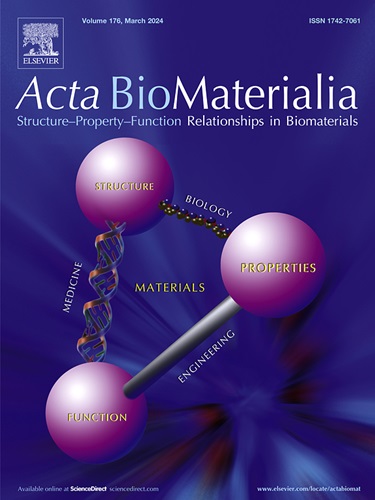内皮糖萼成熟度与毒性和细胞内带电纳米颗粒摄取之间的相互作用。
IF 9.4
1区 医学
Q1 ENGINEERING, BIOMEDICAL
引用次数: 0
摘要
纳米粒子被广泛研究用于向目标组织提供治疗,但很少有临床应用。大多数纳米颗粒在到达目标组织的途中会遇到血管。这些血管的内表面排列着内皮细胞,由糖萼覆盖,这是一种富含阴离子聚糖的细胞外基质。糖萼在纳米颗粒相互作用中的作用尚不清楚。在这里,我们证明内皮细胞需要延长培养时间来合成成熟的糖萼。我们的研究表明,支链聚乙烯亚胺功能化的金纳米颗粒与表达发育或成熟糖萼的内皮细胞结合,并与透明质酸和硫酸肝素相互作用。这些纳米颗粒随后被内化。聚l -精氨酸也有类似的结果。成熟的糖萼通过降低这些阳离子纳米颗粒的毒性来保护细胞。相比之下,硫辛酸功能化的金纳米颗粒被发育中的糖萼细胞吸收,而不是成熟的糖萼细胞。聚(l -谷氨酸)仅在糖萼中的主要聚糖被降解时才与细胞相互作用。这些发现强调了纳米颗粒电荷和结构之间的复杂关系,以及它们对内皮细胞的毒性、结合和摄取的影响。这为改善纳米颗粒在健康和疾病中与血管的相互作用提供了重要的见解。意义说明:血管内壁的内皮细胞形成了一个屏障,纳米颗粒必须穿过这个屏障才能到达目标组织。这些细胞被一层称为糖萼的物质所覆盖,其中含有丰富的阴离子聚糖。然而,糖萼在纳米颗粒如何与细胞相互作用中的作用仍未得到充分研究。我们的研究表明,具有成熟糖萼的细胞内化了阳离子纳米颗粒,并降低了细胞毒性。相反,成熟的糖萼阻止阴离子纳米粒子进入细胞。这些结果表明,在未来的研究中应该考虑纳米颗粒和糖萼的结构,以提高纳米颗粒在医学上的应用。本文章由计算机程序翻译,如有差异,请以英文原文为准。

The interplay between endothelial glycocalyx maturity and both the toxicity and intracellular uptake of charged nanoparticles
Nanoparticles are widely studied for delivering treatments to target tissues, but few have reached clinical use. Most nanoparticles encounter blood vessels on their way to target tissues. The inner surface of these vessels is lined with endothelial cells covered by a glycocalyx, an extracellular matrix rich in anionic glycans. The role of the glycocalyx in nanoparticle interactions is not well understood. Here, we demonstrate that endothelial cells need extended culture times to synthesize a mature glycocalyx. Our research shows that branched polyethyleneimine functionalized gold nanoparticles bind to endothelial cells expressing either a developing or mature glycocalyx, with the interaction involving hyaluronan and heparan sulfate. These nanoparticles are subsequently internalized. Similar results were seen with poly(L-arginine). A mature glycocalyx protects cells by reducing the toxicity of these cationic nanoparticles. In contrast, lipoic acid-functionalized gold nanoparticles are internalized by cells with a developing glycocalyx, but not a mature one. Poly(L-glutamic acid) only interacts with cells when major glycans in the glycocalyx are degraded. These findings highlight the complex relationship between nanoparticle charge and structure, and their effects on toxicity, binding, and uptake by endothelial cells. This offers important insights for improving nanoparticle interactions with blood vessels in health and disease.
Statement of Significance
Endothelial cells lining blood vessels form a barrier through which nanoparticles must cross to reach target tissues. These cells are covered with a layer called the glycocalyx, which is rich in anionic glycans. However, the role of the glycocalyx in how nanoparticles interact with cells remains underexplored.
Our research revealed that cells with a mature glycocalyx internalize cationic nanoparticles and experience reduced cytotoxicity. Conversely, a mature glycocalyx prevents anionic nanoparticles from entering cells. These results suggest that the structure of both the nanoparticles and the glycocalyx should be considered in future studies to improve the use of nanoparticles for medical applications.
求助全文
通过发布文献求助,成功后即可免费获取论文全文。
去求助
来源期刊

Acta Biomaterialia
工程技术-材料科学:生物材料
CiteScore
16.80
自引率
3.10%
发文量
776
审稿时长
30 days
期刊介绍:
Acta Biomaterialia is a monthly peer-reviewed scientific journal published by Elsevier. The journal was established in January 2005. The editor-in-chief is W.R. Wagner (University of Pittsburgh). The journal covers research in biomaterials science, including the interrelationship of biomaterial structure and function from macroscale to nanoscale. Topical coverage includes biomedical and biocompatible materials.
 求助内容:
求助内容: 应助结果提醒方式:
应助结果提醒方式:


